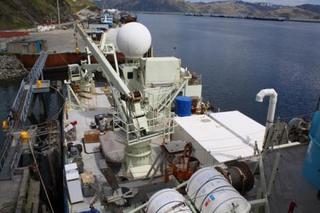Scientists seek predictive understanding of the Bering Sea

Thursday, June 18 2009
Unalaska, AK – The Navy-owned research vessel Knorr passed through Unalaska last week hosting a team of scientists from the BEST/BSIERP Bering Sea Ecosystem research project. For the third year in a row, scientists are gathering data on all aspects of the ecosystem, from water chemistry to phytoplankton to marine mammals. This is the third research cruise for the project this year. This time they will be sampling in shallow areas in the eastern Bering Sea to gather oceanographic information and take samples of phytoplankton, zooplankton, and larval fish.
"What we're shooting for here is a bottom to top integrated analysis of the system starting from the physics and chemistry of the water going all the way up to the plankton, zooplankton, fisheries, and eventually marine birds and mammals," said Knorr Chief Scientist Ray Sambrotto.
The four-year long project aims to gather enough data for the scientists to create predictive models of the ecosystem. They already know the basics. When the ice melts, pools of fresh water sit near the top of the ocean and the phytoplankton flourish in the light-filled environment. The ice melt also includes sediments from land that contain vital nutrients, like iron, that increase production. The bloom is so intense that it can be viewed from space.
"You get this enormous production of plankton," Sambrotto said, "but within a few days it starts to sink. And since it's less than 100 meters deep a lot of that stuff reaches the bottom. So that initial pulse is used by almost all of the creatures that live on the bottom."
The benthic, or bottom level, organisms even plan their reproduction cycles around the bloom. Although the researchers know the basics of the system, they don't know the details.
"We know the kind of general 'A' goes to 'B' goes to 'C.' But we really don't have a predictive understanding of what happens if 'A' changes. And if 'A' in this case is the ice, we know it's going to have an impact. But there are going to be winners and there are going to be losers in that scenario."
Sambrotto said they're developing predictive models that will help people know how sea ice changes will affect commercial species, like crab and pollock, as well as subsistence species. The study isn't long enough to build a complete climate model of the region, but it will provide more integrated ecosystem data than ever before available.
The 34 scientists on the Knorr will spend the next month criss-crossing across the eastern Bering Sea along transect lines from the Aleutians up to St. Lawrence Island collecting samples. The research will be completed in 2010. It's funded through the National Science Foundation and the North Pacific Research Board.



